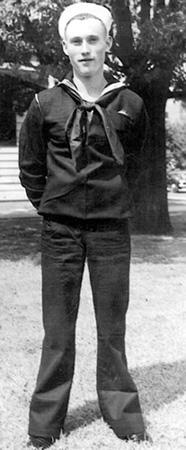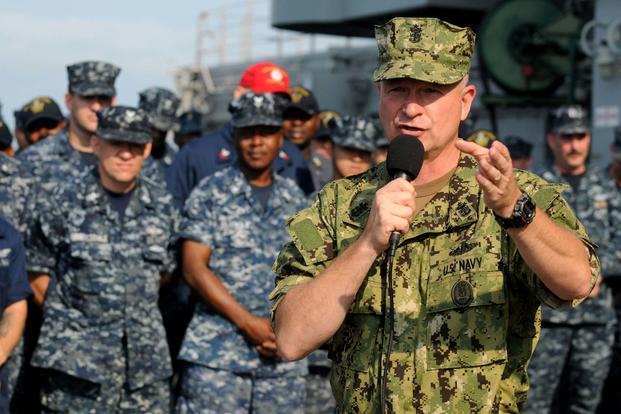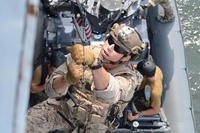The birth of the U.S. Navy didn't take place until a few months after the start of the Revolutionary War, and it was disbanded shortly after. It wasn't brought back into existence for nearly 20 years, and it wasn't until 1817 that the first official uniforms were created. The War Department officially declared that enlisted sailors wear "blue jackets and trousers, red vest with yellow buttons and a black hat." But at that time, funding was short so uniform regulations were not heavily enforced. Certain aspects of the uniform evolved over time to signify ranks such as master-at-arms, yeoman, and to distinguish officers.
Due to the size and complexity of warships in the 1800s, the rank of chief petty officer was established to help organize and manage day-to-day operations. Those who achieved this rank tended to have spent more time serving in the military and welcomed the addition of service stripes to reflect their length of service.

While the original uniforms used string to holds pants at the waist, buttons soon took over. In 1864, a flap at the front of the trousers was implemented that required seven buttons to hold up. In 1894, the flap was lengthened, and six more buttons were added. Eventually, string reappeared at the back of the waist to help sailors whose pants needed an extra cinch when the buttons failed.
Bell-bottoms, another iconic aspect of classic Navy uniforms, supposedly were implemented in the 1800s to distinguish sailors from civilian fashion. Perhaps unintentionally, bell-bottoms proved extremely useful. They were rolled easily above the knee to keep legs dry and allowed sailors to remove them quickly while still wearing their shoes in case they were tossed overboard.
Neckerchiefs were common at the time among men working on ships since they were convenient sweat rags. They were useful enough that the Navy codified a standard-issue neckerchief with a square knot in 1817. It was common to use a coin to keep the neckerchief's shape while rolling it. There are many claims that this is a nod to the Greek myth of deceased individuals needing a coin for the ferryman on the river Styx to take them to the underworld. However, there is no evidence to suggest that this is the origin of the practice.
The early 1900s saw two major changes to Navy uniforms: denim for jumpers and trousers, and uniforms for newly enlisted women. Female uniforms tended to reflect civilian fashion rather than maritime traditions, and it wasn't until World War II that the Navy updated this trend.

Among a few traditional aspects of the uniform to change in the 1940s was the removal of the hat-band ribbon in 1941. These ribbons used to feature a sailor's unit name on the flat of the hat, but these distinctions eventually were shifted to the shoulder for security reasons.
Major changes to the uniform took place in 1973. Many sailors in leadership roles, including many senior petty officers, wanted their uniforms to appear more distinguished. Traditional uniforms were replaced with suits and ties that were more in line with CPO and officer regulations. The idea was to present the modern Navy as a unified force, but these changes weren't taken well and largely were reversed by 1980. At that point, women received uniforms that were more practical, functional and indicative of American naval traditions.
Current Navy uniforms maintain a number of traditions stemming from its formation, including jumpers and neckerchiefs.
Interested in Joining the Military?
We can put you in touch with recruiters from the different military branches. Learn about the benefits of serving your country, paying for school, military career paths, and more: sign up now and hear from a recruiter near you.














